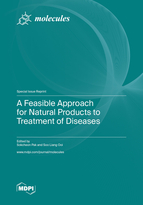A Feasible Approach for Natural Products to Treatment of Diseases
A special issue of Molecules (ISSN 1420-3049). This special issue belongs to the section "Natural Products Chemistry".
Deadline for manuscript submissions: closed (31 January 2023) | Viewed by 36438
Special Issue Editors
Interests: evidence-based practice; bee venom; nutrition; reproduction; cancer; natural medicine
Special Issues, Collections and Topics in MDPI journals
Interests: evidence-based complementary medicine; nutrition; naturopathy; phytotherapy; natural medicine
Special Issues, Collections and Topics in MDPI journals
Special Issue Information
Dear Colleagues,
A natural product is a compound or substance that originated from living beings. Natural products from both plant and animal sources have been used to treat diseases and illnesses since ancient times. Roots, leaves, rhizomes, or barks of medicinal plants are commonly featured in the herbal preparations of many traditional medicinal systems. Similarly, hooves, skins, bones, feathers, and tusks can be essential ingredients in the preparation of Indigenous curative or protective remedies. Many natural products, such as curcumin from turmeric, catechin from green tea, and astaxanthin from shellfish, are consumed as herbal remedies, functional foods, nutritional supplements, or wellness products to improve health and wellbeing, especially among many with underlying chronic conditions.
Modern medicine has also benefited from the characterisation of lead compounds from natural products. Acetylsalicylic acid, or more commonly known as aspirin, is a synthetic derivative of salicylic acid naturally found in willow bark, a traditional pain remedy. Quinine, a medication used to treat malaria, is a bitter compound that comes from the cinchona tree bark. Furthermore, Taxanes, a class of diterpenes initially identified from plants of the genus Taxus, are the mainstay chemotherapy today in the form of paclitaxel and docetaxel. In fact, over 60% of the current anticancer drugs were derived from natural sources, in one way or another.
The potential of natural products for the treatment of diseases remains enormous as our understanding so far is just the tip of an iceberg. Much preclinical and clinical research is required to uncover the active constituents, mechanisms of actions, pharmacokinetics, safety, and toxicity of natural products for therapeutic use. Other issues to address include extraction, isolation, and standardisation of any naturally derived compounds and their effective mode of therapeutic delivery. Hence, much research is needed before any natural products can be feasibly applied in treatment.
In this Special Issue, we invite researchers to contribute recent original research and review articles that will strengthen knowledge of not only the therapeutic or preventative utilities of natural products but also the mechanisms, methods or processes of treatment.
Dr. Sokcheon Pak
Dr. Soo Liang Ooi
Guest Editors
Manuscript Submission Information
Manuscripts should be submitted online at www.mdpi.com by registering and logging in to this website. Once you are registered, click here to go to the submission form. Manuscripts can be submitted until the deadline. All submissions that pass pre-check are peer-reviewed. Accepted papers will be published continuously in the journal (as soon as accepted) and will be listed together on the special issue website. Research articles, review articles as well as short communications are invited. For planned papers, a title and short abstract (about 100 words) can be sent to the Editorial Office for announcement on this website.
Submitted manuscripts should not have been published previously, nor be under consideration for publication elsewhere (except conference proceedings papers). All manuscripts are thoroughly refereed through a single-blind peer-review process. A guide for authors and other relevant information for submission of manuscripts is available on the Instructions for Authors page. Molecules is an international peer-reviewed open access semimonthly journal published by MDPI.
Please visit the Instructions for Authors page before submitting a manuscript. The Article Processing Charge (APC) for publication in this open access journal is 2700 CHF (Swiss Francs). Submitted papers should be well formatted and use good English. Authors may use MDPI's English editing service prior to publication or during author revisions.
Keywords
- traditional medicine
- flavonoids
- anti-inflammatory agents
- chemotherapy
- active compounds
- nanotechnology








